Pattern 1939 Leather Infantry Equipment
Equipment Carriers and Cases
For these, stitching was additionally used to close the side seam of the Pistol case only.
Carrier, cartridge, Pattern 1939, Leather
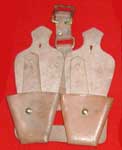
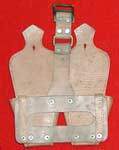
 The nomenclature is reproduced here in full, as it is one of only two, which is supported by official documentation!
The nomenclature is reproduced here in full, as it is one of only two, which is supported by official documentation!
This would have been an easy creation, as it’s effectively two pockets cut from the middle of a Patt. ’03 B.E. Bandolier. Belt loops were formed with narrow strips of leather riveted to the upper horizontal backing strip, curved over and riveted flat to the lower strip. The standard form of the Patt. ’37 attachment point for the Brace was reproduced in leather, even the oval brass ring and the flared lower section, where it was riveted to the upper backing strip. In Patt. ’37, this flare formed a fairlead for the Brace to be threaded through. In Patt. ’39, this refinement was dispensed with. Internally, the same B.E. style Guard Straps were fitted, allowing the front charger to be secured, when the rear charger was withdrawn. Examples at left from the Tom Ready Collection, photos © Tom Ready, 2010. Photograph at right courtesy of 'Viktor' of the WWII Re-enacting Forum.
The nomenclature is italicised, as this is how it appeared in A.CI. 2187 / 1941. This authorised a modification, whereby the existing Stud, brass, bandolier was removed and a new one fitted half an inch higher. This was for units equipped with rifles using .300 ammunition, namely the M-1917 version of of the Rifle, No. 3, or P.’14. This was a weapon known to have been issued to the Home Guard, but whether “…units…” referred to them, or training units, is not known. The pockets were designed for .303 rounds in chargers, whereas the M-1917 used clips and the rounds were slightly longer than .303. The 1942 H.G. Scale does not include Cartridge carriers, but photographs of H.G. are known. The Pattern ’37 Carrier had a checkered history, being made obsolescent by L. of C. §B5282 in July 1941, then re-introduced by L. of C. §B6365 in June 1942. Since Patt. ’39 was a back-up to Patt. ’37, it may be these LoCs were mirrored in Patt. ’39?
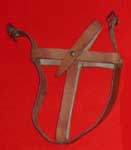
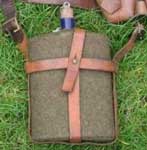 This replicated the 1st Issue Carrier, the skeleton form, of Patt. ’37. Where other items of Patt. ’39 used a press fastener, closure of the securing strap was effected simply by a pillar stud. Either of the Bottles, water, enamelled, Mark VI, or Mark VII would fit, though it is not known if the Bottle, water, aluminium ever found its way into training units. Example far left is from the Tom Ready Collection. Photo © Tom Ready, 2010. Near left, courtesy of War Department Militaria, © Paul Laidlaw 2010.
This replicated the 1st Issue Carrier, the skeleton form, of Patt. ’37. Where other items of Patt. ’39 used a press fastener, closure of the securing strap was effected simply by a pillar stud. Either of the Bottles, water, enamelled, Mark VI, or Mark VII would fit, though it is not known if the Bottle, water, aluminium ever found its way into training units. Example far left is from the Tom Ready Collection. Photo © Tom Ready, 2010. Near left, courtesy of War Department Militaria, © Paul Laidlaw 2010.
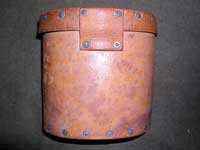
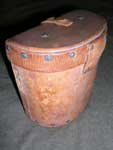
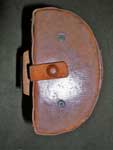 This was a most un-usual item, looking more like an envelope for the D-section Tin, mess, D.S. The shape allowed binoculars of various forms, sourced from civilian loans / gifts and from foreign stocks, such was the shortage of binoculars.
This was a most un-usual item, looking more like an envelope for the D-section Tin, mess, D.S. The shape allowed binoculars of various forms, sourced from civilian loans / gifts and from foreign stocks, such was the shortage of binoculars.
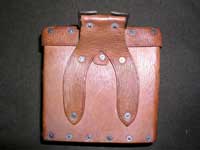
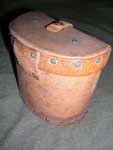
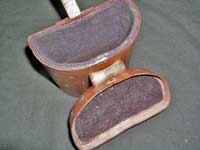 A 2-inch buckle, carried on a “V” strap, rather like that of Patt. ’14, was riveted to the rear face. As with that Pattern, this arrangement allowed the Brace to be passed down through the apex of the “V”. A press-fastener and tab, fixed behind the Case, was fastened to the spigot half of the press-fastener, which was riveted in the top of the lid. The D-shaped box-lid, which was hinged by a riveted patch on the front. The buckle connected to a corresponding tab on the Compass pocket, the “V” strap allowing the Brace to pass behind the Binocular case. Internally, both body and lid were lined with thick, coarse felt padding. All photos courtesy of War Department Militaria, © Paul Laidlaw 2010.
A 2-inch buckle, carried on a “V” strap, rather like that of Patt. ’14, was riveted to the rear face. As with that Pattern, this arrangement allowed the Brace to be passed down through the apex of the “V”. A press-fastener and tab, fixed behind the Case, was fastened to the spigot half of the press-fastener, which was riveted in the top of the lid. The D-shaped box-lid, which was hinged by a riveted patch on the front. The buckle connected to a corresponding tab on the Compass pocket, the “V” strap allowing the Brace to pass behind the Binocular case. Internally, both body and lid were lined with thick, coarse felt padding. All photos courtesy of War Department Militaria, © Paul Laidlaw 2010.
Case, binocular (buckle removed)
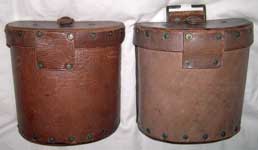
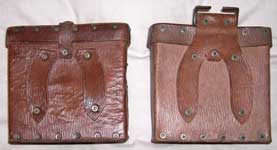 The Case not being equipped with a Steady Hook, this modification refers to the 2-inch buckle on the “V” strap being cut-off. At left are “before and after” examples. From the Chris Pollendine Collection. Photographs © Chris Pollendine, 2010.
The Case not being equipped with a Steady Hook, this modification refers to the 2-inch buckle on the “V” strap being cut-off. At left are “before and after” examples. From the Chris Pollendine Collection. Photographs © Chris Pollendine, 2010.
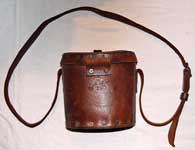
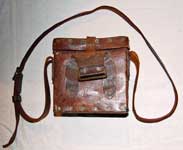
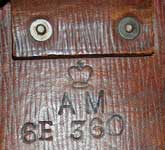 Examples of modified Cases are known, where a shoulder sling has been rivetted on, allowing for normal carriage, in “civilian” fashion. Since more than one example is known, all R.A.F. marked, it would appear to be evidence of an official modification by the R.A.F.. The 2-inch buckles and “V” straps were left intact.
Examples of modified Cases are known, where a shoulder sling has been rivetted on, allowing for normal carriage, in “civilian” fashion. Since more than one example is known, all R.A.F. marked, it would appear to be evidence of an official modification by the R.A.F.. The 2-inch buckles and “V” straps were left intact.
The example at left contained a pair of U.S. Signal Corps binoculars, both they and the Case being stamped up with the R.A.F. A.P. 1086 code of 6E 360 on the front, surmounted by a Crown over A.M.. From the R.J. Dennis Collection. Photographs © R.J. Dennis, 2010.
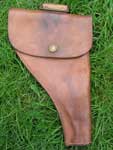
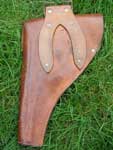 In shape, this was a hybrid of Sam Browne and Patt. ’37, retaining the Patt. ’37 shape of flap, fastened with a press stud and the elegant curves of a Sam Browne Pistol case. Unlike the latter, which was butt-stitched, that for Patt. ’39 was a folded single piece, flat stitched into shape. A tear-drop shaped muzzle cap was stitched inside. The rear was fitted with a 2-inch buckle on a “Y” strap, this mating with a tab on the Ammunition pocket.
Photos courtesy of War Department Militaria, © Paul Laidlaw 2010.
In shape, this was a hybrid of Sam Browne and Patt. ’37, retaining the Patt. ’37 shape of flap, fastened with a press stud and the elegant curves of a Sam Browne Pistol case. Unlike the latter, which was butt-stitched, that for Patt. ’39 was a folded single piece, flat stitched into shape. A tear-drop shaped muzzle cap was stitched inside. The rear was fitted with a 2-inch buckle on a “Y” strap, this mating with a tab on the Ammunition pocket.
Photos courtesy of War Department Militaria, © Paul Laidlaw 2010.
Case, pistol, 1st Issue (buckle removed)
These have had the 2-inch buckle on the “V” strap cut-off.
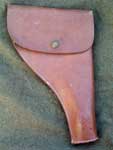
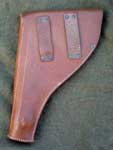
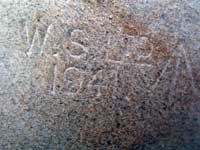 The colloquial, collector’s term for this simplified version is “Patt. ‘40”, where the rear face was fitted only with two belt loops. The question “Why?” then arises, since no documentation exists to inform. In many photographs of Patt. ’37 W.E., it is quite usual to see just Belt, Holster and Ammunition pouch. There would be numerous instances where an officer had to be armed, but not fully accoutred for Field Service. That being the case, perhaps the simplified Case was the answer, dispensing with a 2-inch buckle, un-used and flopping about untidily over the Holster flap. At a time of material shortages, it would certainly also save brass and leather. Unless sufficient dated examples can be found, it cannot be stated that this superseded the original Pistol case. The example shown here is maker marked "W.S. Ltd." and dated 1941. Photos courtesy of War Department Militaria, © Paul Laidlaw 2010.
The colloquial, collector’s term for this simplified version is “Patt. ‘40”, where the rear face was fitted only with two belt loops. The question “Why?” then arises, since no documentation exists to inform. In many photographs of Patt. ’37 W.E., it is quite usual to see just Belt, Holster and Ammunition pouch. There would be numerous instances where an officer had to be armed, but not fully accoutred for Field Service. That being the case, perhaps the simplified Case was the answer, dispensing with a 2-inch buckle, un-used and flopping about untidily over the Holster flap. At a time of material shortages, it would certainly also save brass and leather. Unless sufficient dated examples can be found, it cannot be stated that this superseded the original Pistol case. The example shown here is maker marked "W.S. Ltd." and dated 1941. Photos courtesy of War Department Militaria, © Paul Laidlaw 2010.
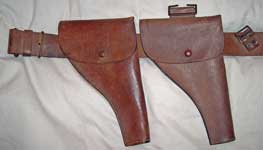
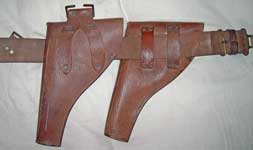 At left are the two Issues of Pistol case, the 2nd Issue threaded on the Waist belt. The belt loops of the 1st Issue are flat-rivetted, with no concession to feeding the belt through, which has to be dis-assembled before it is feasible. Sensibly, the design ought to have attached the top of the loop - turned over - to give clearance, with only the bottom end flat-rivetted. From the Chris Pollendine Collection. Photographs © Chris Pollendine, 2010.
At left are the two Issues of Pistol case, the 2nd Issue threaded on the Waist belt. The belt loops of the 1st Issue are flat-rivetted, with no concession to feeding the belt through, which has to be dis-assembled before it is feasible. Sensibly, the design ought to have attached the top of the loop - turned over - to give clearance, with only the bottom end flat-rivetted. From the Chris Pollendine Collection. Photographs © Chris Pollendine, 2010.
Rog Dennis, December, 2010